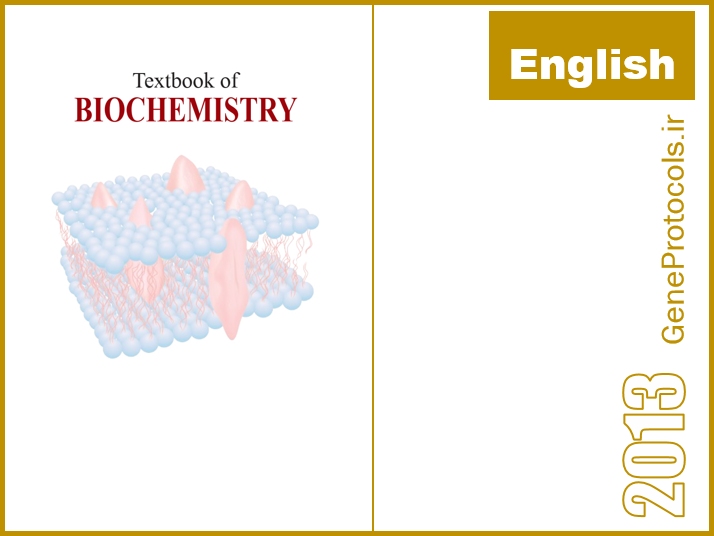|
فهرست مطالب:
Contents
SECTION A: Chemical Basis of Life
1. Biochemical Perspective to Medicine 3
Biomolecules 4; Study of metabolic processes 5; Stabilizing forces in molecules 5; Water: the universal solvent 6;
Principles of thermodynamics 7; Donnan membrane equilibrium 8
2. Subcellular Organelles and Cell Membranes 10
Subcellular organelles 10; Nucleus 10; Endoplasmic reticulum 11; Golgi apparatus 12; Lysosomes 12; Peroxisomes 13;
Mitochondria 13; Plasma membrane 14; Specialized membrane structures 16; Transport mechanisms 17
3. Amino Acids: Structure and Properties 24
Classification of amino acids 24; Properties of amino acids 27;
General reactions of amino acids 29; Peptide bond formation 31
4. Proteins: Structure and Function 33
Structure of proteins 34; Study of protein structure 39; Physical properties of proteins 41;
Precipitation reactions of proteins 41; Classification of proteins 42; Quantitative estimation 44
5. Enzymology: General Concepts and Enzyme Kinetics 47
Classification of enzymes 48; Co-enzymes 49; Mode of action of enzymes 51; Michaelis-Menten theory 53; Fischer's template theory 53;
Koshland's induced fit theory 53; Active site or active center of enzyme 54; Thermodynamic considerations 54; Enzyme kinetics 55;
Factors influencing enzyme activity 56; Specificity of enzymes 65; Iso-enzymes 66
6. Chemistry of Carbohydrates 69
Nomenclature 69; Stereoisomers 70; Reactions of monosaccharides 73; Disaccharides 76; Polysaccharides 78;
Heteroglycans 79; Mucopolysaccharides 80; Glycoproteins and mucoproteins 81
7. Chemistry of Lipids 83
Classification of lipids 83; Fatty acids 84; Saturated fatty acids 85; Unsaturated fatty acids 85;
Trans fatty acids 86; Neutral fats 87; Phospholipids 89
SECTION B: General Metabolism
8. Overview of Metabolism 97
Experimental study of metabolism 97; Metabolism 98; Metabolic profile of organs 99
9. Major Metabolic Pathways of Glucose 105
Digestion of carbohydrates 105; Absorption of carbohydrates 106; Glucose metabolism 107;
Glycolysis 108; Metabolic fate of pyruvate 115; Gluconeogenesis 117
10. Other Metabolic Pathways of Glucose 123
Glycogen metabolism 123; Degradation of glycogen (glycogenolysis) 124; Glycogen synthesis (glycogenesis) 125;
Glycogen storage diseases 128; Hexose monophosphate shunt pathway 129; Oxidative phase 130; Non-oxidative phase 130;
Glucuronic acid pathway of glucose 134; Polyol pathway of glucose 135xii Textbook of Biochemistry
11. Metabolic Pathways of Other Carbohydrates 137
Fructose metabolism 137; Galactose metabolism 138; Metabolism of alcohol 140; Metabolism of amino sugars 142; Glycoproteins 142
12. Metabolism of Fatty Acids 147
Digestion of lipids 147; Absorption of lipids 148; Beta oxidation of fatty acids 151; Oxidation of odd chain fatty acids 154; Alpha oxidation 155;
Omega oxidation 155; De novo synthesis of fatty acids 156; Synthesis of triacylglycerols 160; Metabolism of adipose tissue 161;
Fatty liver and lipotropic factors 162; Metabolism of ketone bodies 163; Ketosis 164
13. Cholesterol and Lipoproteins 169
Biosynthesis of cholesterol 170; Plasma lipids 173; Chylomicrons 175; Very low density lipoproteins 176;
Low density lipoproteins 177; High density lipoprotein 179; Free fatty acid 181; Formation of bile acids 182
14. MCFA, PUFA, Prostaglandins and Compound Lipids 184
Monounsaturated fatty acids 185; Polyunsaturated fatty acids 186; Eicosanoids 188; Prostaglandins 188; Synthesis of compound lipids 191
15. General Amino Acid Metabolism (Urea Cycle, One Carbon Metabolism) 196
Digestion of proteins 196; Formation of ammonia 200; Disposal/detoxification of ammonia 203; Urea cycle 203; One-carbon metabolism 207
16. Simple, Hydroxy and Sulfur-containing Amino Acids (Glycine, Serine, Methionine, Cysteine) 210
Glycine 210; Creatine and creatine phosphate 211; Serine 213; Alanine 215; Threonine 215;
Methionine 216; Cysteine 217; Cystinuria 219; Homocystinurias 220
17. Acidic, Basic and Branched Chain Amino Acids (Glutamic Acid, Aspartic Acid, Glutamine, Asparagine,
Lysine, Arginine, Nitric Oxide, Valine, Leucine, Isoleucine) 223
Glutamic acid 223; Glutamine 224; Glutamate transporters 225; Aspartic acid 226;
Asparagine 226; Arginine 226; Nitric oxide 227; Polyamines 229; Branched chain amino acids 230
18. Aromatic Amino Acids (Phenylalanine, Tyrosine, Tryptophan, Histidine, Proline) and Amino Acidurias 232
Phenylalanine 232; Tyrosine 233; Phenylketonuria 236; Alkaptonuria 237; Albinism 238;
Hypertyrosinemias 239; Tryptophan 239; Histidine 243; Proline and hydroxyproline 244; Aminoacidurias 245
19. Citric Acid Cycle 247
Regulation of citric acid cycle 253
20. Biological Oxidation and Electron Transport Chain 255
Redox potentials 256; Biological oxidation 256; Enzymes and co-enzymes 257; High energy compounds 258;
Organization of electron transport chain 260; Chemiosmotic theory 263
21. Heme Synthesis and Breakdown 270
Structure of heme 270; Biosynthesis of heme 271; Catabolism of heme 276; Hyperbilirubinemias 279
22. Hemoglobin (Structure, Oxygen and Carbon Dioxide Transport, Abnormal Hemoglobins) 283
Structure of hemoglobin 283; Transport of oxygen by hemoglobin 284; Transport of carbon dioxide 287; Hemoglobin derivatives 289;
Hemoglobin (globin chain) variants 290; Thalassemias 293; Myoglobin 294; Anemias 295; Hemolytic anemia 295
SECTION C: Clinical and Applied Biochemistry
23. Clinical Enzymology and Biomarkers 301
Clinical enzymology 301; Creatine kinase 302; Cardiac troponins 303; Lactate dehydrogenase 303;
Alanine amino transferase 305; Aspartate amino transferase 305; Alkaline phosphatase 305;
Prostate specific antigen 306; Glucose-6-phosphate dehydrogenase 307; Amylase 307; Lipase 308; Enolase 308
24. Regulation of Blood Glucose; Insulin and Diabetes Mellitus 311
Regulation of blood glucose 311; Reducing substances in urine 316; Hyperglycemic hormones 322;
Glucagon 322; Diabetes mellitus 323; Acute metabolic complications 326Contents xiii
25. Hyperlipidemias and Cardiovascular Diseases 334
Atherosclerosis 334; Plasma lipid profile 336; Risk factors for atherosclerosis 336;
Prevention of atherosclerosis 339; Hypolipoproteinemias 341; Hyperlipidemias 342
26. Liver and Gastric Function Tests 346
Functions of liver 346; Clinical manifestations of liver dysfunction 348; Studies on malabsorption 359
27. Kidney Function Tests 361
Renal function tests 361; Abnormal constituents of urine 364; Markers of glomerular filtration rate 366;
Markers of glomerular permeability 371; Tests for tubular function 373
28. Plasma Proteins 378
Electrophoresis 378; Albumin 380; Transport proteins 382;
Acute phase proteins 383; Clotting factors 385; Abnormalities in coagulation 386
29. Acid-Base Balance and pH 390
Acids and bases 390; Buffers 392; Acid-base balance 393; Buffers of the body fluids 393; Respiratory regulation of pH 395;
Renal regulation of pH 395; Cellular buffers 397; Disturbances in acid-base balance 397
30. Electrolyte and Water Balance 407
Intake and output of water 407; Osmolality of extracellular fluid 408;
Sodium 411; Potassium 413; Chloride 416
31. Body Fluids (Milk, CSF, Amniotic Fluid, Ascitic Fluid) 420
Milk 420; Cerebrospinal fluid 421; Amniotic fluid 422; Ascitic fluid 423
32. Metabolic Diseases 424
Prenatal diagnosis 424; Newborn screening 427; Laboratory investigations to diagnose metabolic disorders 427
33. Free Radicals and Antioxidants 433
Clinical significance 436
34. Clinical Laboratory; Quality Control 439
Reference values 439; Preanalytical variables 440; Specimen collection 441; Quality control 443
35. General Techniques for Separation, Purification and Quantitation 446
Electrophoresis 446; Chromatography 448; Radioimmunoassay 452; ELISA test 453;
Colorimeter 455; Autoanalyzer 457; Mass spectrometry 458
SECTION D: Nutrition
36. Fat Soluble Vitamins (A, D, E, K) 463
Vitamin A 464; Vitamin D (cholecalciferol) 469; Vitamin E 473; Vitamin K 474
37. Water Soluble Vitamins - 1 (Thiamine, Riboflavin, Niacin, Pyridoxine, Pantothenic Acid, Biotin) 477
Thiamine (vitamin B
1 ) 477; Riboflavin (vitamin B2 ) 479; Niacin 480; Vitamin B6 482; Pantothenic acid 484; Biotin 485
38. Water Soluble Vitamins - 2 (Folic Acid, Vitamin B
12 and Ascorbic Acid) 488
Folic acid 488; Vitamin B
12 491; Choline 494; Inositol 495; Ascorbic acid (vitamin C) 495; Rutin 499; Flavonoids 499
39. Mineral Metabolism and Abnormalities 502
Calcium 502; Phosphorus 511; Magnesium 512; Sulfur 513; Iron 514; Copper 520; Iodine 521; Zinc 522; Fluoride 522;
Selenium 522; Manganese 523; Molybdenum 523; Cobalt 523; Nickel 523; Chromium 523; Lithium 524xiv Textbook of Biochemistry
40. Energy Metabolism and Nutrition 527
Importance of carbohydrates 530; Nutritional importance of lipids 531; Importance of proteins 532;
Protein-energy malnutrition 534; Obesity 536; Prescription of diet 538
41. Detoxification and Biotransformation of Xenobiotics 544
Phase one reactions 545; Phase two reactions; conjugations 546; Phase three reactions 548
42. Environmental Pollution and Heavy Metal Poisons 550
Corrosives 550; Irritants 551; Heavy metal poisons 551; Pesticides and insecticides 553;
Occupational and industrial hazards 553; Air pollutants 553
SECTION E: Molecular Biology
43. Nucleotides: Chemistry and Metabolism 559
Biosynthesis of purine nucleotides 563; Uric acid 566; Gout 566; De novo synthesis of pyrimidine 569
44. Deoxyribonucleic Acid: Structure and Replication 574
Structure of DNA 574; Replication of DNA 578; DNA repair mechanisms 582
45. Transcription 587
Ribonucleic acid 587; Transcription process 589
46. Genetic Code and Translation 596
Protein biosynthesis 596; Translation process 599
47. Control of Gene Expression 608
Mutations 612; Classification of mutations 612; Cell cycle 614; Regulation of gene expression 616; Viruses 620
48. Recombinant DNA Technology and Gene Therapy 624
Recombinant DNA technology 624; Vectors 626; Gene therapy 629; Stem cells 631
49. Molecular Diagnostics and Genetic Techniques 633
Hybridization and blot techniques 633; Polymerase chain reaction 638; Mutation detection techniques 641
SECTION F: Hormones
50. Mechanisms of Action of Hormones and Signaling Molecules 649
51. Hypothalamic and Pituitary Hormones 659
Hypothalamic neuropeptides 659; Hormones of anterior pituitary 660
52. Steroid Hormones 664
Adrenal cortical hormones 664; Sex hormones 669
53. Thyroid Hormones 672
54. Gut Hormones 678
SECTION G: Advanced Biochemistry
55. Immunochemistry 685
Structure of immunoglobulins 687; Paraproteinemias 690; Complement system 691; Immunodeficiency states 692Contents xv
56. Biochemistry of AIDS and HIV 699
The human immunodeficiency virus 701; Anti-HIV drugs 703
57. Biochemistry of Cancer 705
Oncogenic viruses 707; Oncogenes 709; Tumor markers 713; Anticancer drugs 716
58. Tissue Proteins in Health and Disease 720
Collagen 720; Elastin 723; Muscle proteins 724; Lens proteins 727; Prions 727; Biochemistry of aging 730
59. Applications of Isotopes in Medicine 732
Isotopes 733; Radioactivity 733; Biological effects of radiation 738
60. Signal Molecules and Growth Factors 740
Appendices 747
Index 763
مشخصات فایل
|




